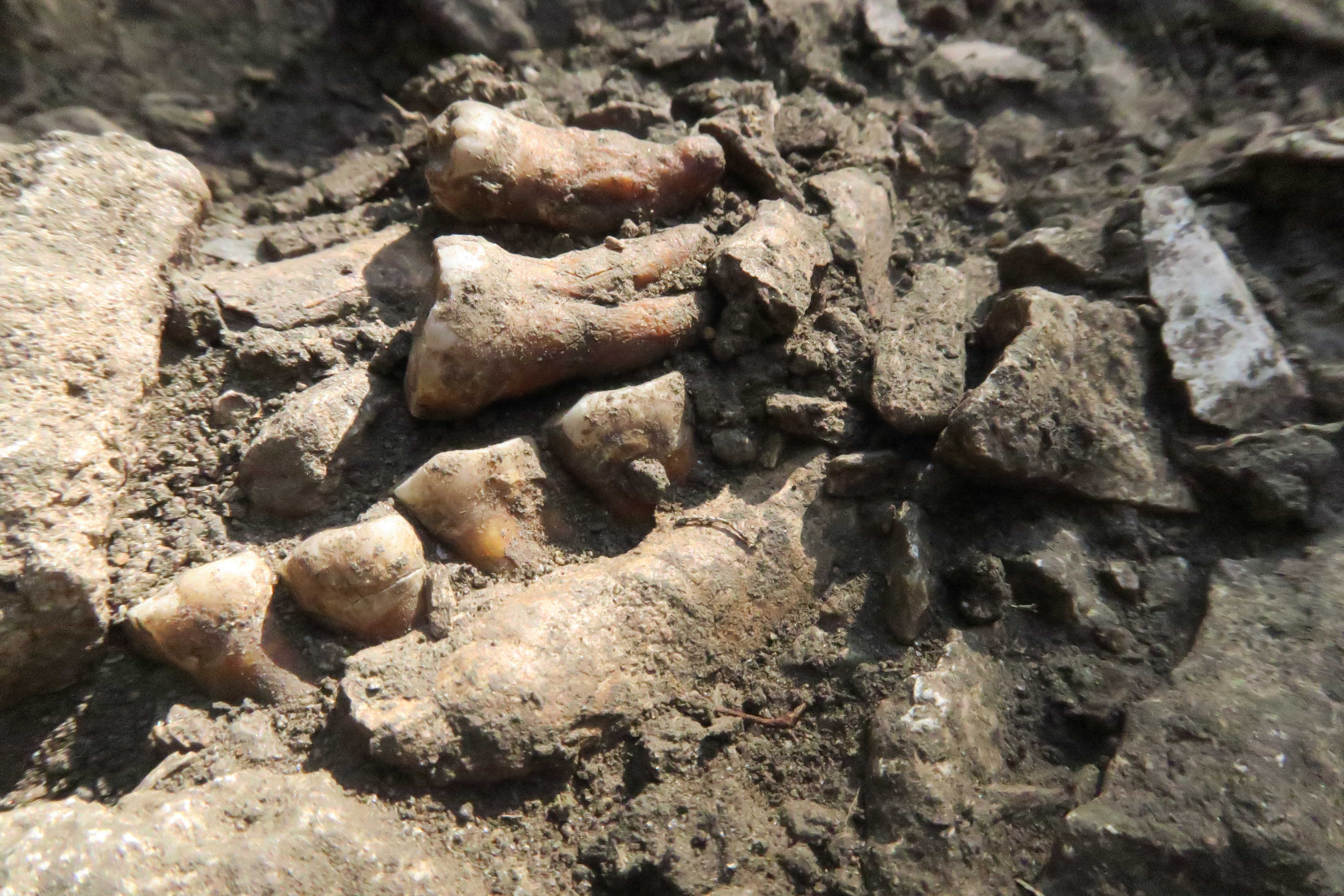Bones
Paleontologists Discover Dinosaur Fossils in Hong Kong for the First Time
The metropolis is an important center for paleontological research, but until now, fossils of plants and fish were the only remains of dinosaur-era life found there
Scientists Think a Skeleton Found in a Well Is the Same Man Described in an 800-Year-Old Norse Text
The remains were discovered during excavations in 1938. Now, researchers have learned new information about his identity by analyzing DNA from his tooth
An Ice Age Infant’s 17,000-Year-Old DNA Reveals He Had Dark Skin and Blue Eyes
The baby boy’s recovered genome suggests he’s related to a famous Ice Age population
Archaeologists in Petra Discover Secret Tomb Hiding Beneath a Mysterious Structure Featured in 'Indiana Jones'
The recent excavation beneath the Treasury has revealed 12 complete human skeletons and a trove of grave goods dating back 2,000 years
Archaeologists Discover Intricately Decorated Coffins Belonging to the Only Daughter of an Ancient Egyptian Governor
The 4,000-year-old burial chamber featured hieroglyphs referring to the woman, known as Idi, as the "lady of the house"
Rare Jaw Fossils Discovered in Texas Shed Light on a 20-Foot-Long Mosasaur
Unearthed last year, the remains could reveal new information on the extinct sea reptile, which crushed mollusks and shelled creatures with its large, round teeth
Archaeologists Say They've Solved the Mystery of a Lead Coffin Discovered Beneath Notre-Dame
New research suggests the sarcophagus' occupant, previously known only as "the horseman," is Joachim du Bellay, a French Renaissance poet who died in 1560
Europeans Were Using Cocaine in the 17th Century—Hundreds of Years Earlier Than Historians Thought
Scientists identified traces of the drug in the brain tissue of two individuals buried in the crypt of a hospital in Milan
Ancient DNA Reveals Neanderthal Group Was Isolated for 50,000 Years
A new study, based on the remains of a Neanderthal nicknamed Thorin, is shaking up what archaeologists long thought about these early humans in Europe
What Happened to the Sodder Children, the Siblings Who Went Up in Smoke in a West Virginia House Fire?
Authorities said the Christmas 1945 blaze was accidental, but the victims' family believed otherwise, theorizing it was an act of arson designed to distract them while their loved ones were kidnapped
Archaeologists May Have Identified the Bones of a Celebrated Ninth-Century Bishop in Spain
Bishop Teodomiro was a central figure in the creation of the Camino de Santiago pilgrimage
‘Fearsome’ Saber-Toothed Cats Needed Their Baby Teeth and Mommies, Too
According to new research, two sets of sabers and unusual lower jaw anatomy show that the saber-toothed cat Smilodon fatalis delayed adulting with a long weaning period
13,600-Year-Old Mastodon Skull Uncovered in Iowa
The hulking creature may have overlapped with Indigenous people
Fossils Shed New Light on Small 'Hobbit-Like' Humans That Lived on a Remote Island
Two teeth and a small adult arm bone found in Indonesia suggest the ancestors of Homo floresiensis were even shorter than scientists previously thought
Why Were There So Many Skeletons Hidden in Benjamin Franklin's Basement?
During restorations in the 1990s, more than 1,200 pieces of bone surfaced beneath the founding father's London home
Was This Giant, Armadillo-Like Animal Butchered by Humans in Argentina 21,000 Years Ago?
The creature's bones show evidence of cutting with stone tools, adding to a series of findings that suggest humans were present in the Americas earlier than thought
Did Plague Cause the Mysterious Collapse of Europe's Early Farmers 5,000 Years Ago?
A new study finds widespread DNA evidence that an ancestor pathogen of the Black Death helped bring about the end of an agricultural society responsible for megalithic tombs and monuments, like Stonehenge
Ancient Egyptian Scribes Were Worked to the Bone
The administrators spent long periods writing in odd postures, which damaged their joints, researchers discovered
Neanderthal Child May Have Had Down Syndrome, Fossil Suggests
The child's survival until at least 6 years old could be evidence of collaborative caregiving in Neanderthal societies, according to a new paper
16th-Century Skeletons of Children Infected With Smallpox Discovered in Peru
The toddlers' remains were buried around the beginning of the Spanish conquest of South America
Page 1 of 15
:focal(2000x1352:2001x1353)/https://tf-cmsv2-smithsonianmag-media.s3.amazonaws.com/filer_public/70/34/70340a12-de14-46a5-9459-7487ab101cc8/p2024102300491_photo_1285200.jpg)
:focal(450x338:451x339)/https://tf-cmsv2-smithsonianmag-media.s3.amazonaws.com/filer_public/8c/09/8c09444b-5a9b-424a-b5bf-4e47be6742ad/gr1_lrg.jpeg)
:focal(847x637:848x638)/https://tf-cmsv2-smithsonianmag-media.s3.amazonaws.com/filer_public/49/a0/49a04cd4-ff2c-4863-abf0-ddab5e58b61d/screen_shot_2024-10-21_at_114341_am.jpeg)
:focal(3360x2240:3361x2241)/https://tf-cmsv2-smithsonianmag-media.s3.amazonaws.com/filer_public/3e/73/3e73c461-9299-4f3a-84d4-69e6de4dbf2b/exu_petra_select_3.jpg)
:focal(597x449:598x450)/https://tf-cmsv2-smithsonianmag-media.s3.amazonaws.com/filer_public/9f/1f/9f1fcb12-a12a-46fd-8f78-d068cd002774/461922747_923476466480567_5816611689939612382_n.jpeg)
:focal(425x320:426x321)/https://tf-cmsv2-smithsonianmag-media.s3.amazonaws.com/filer_public/21/4f/214fb752-d077-486e-a6b2-dca284c50163/globidens-alabamaensis.jpeg)
:focal(960x640:961x641)/https://tf-cmsv2-smithsonianmag-media.s3.amazonaws.com/filer_public/0c/32/0c328f41-e559-4052-a024-cdfe5f12bfed/dsc_6895.jpg)
:focal(598x450:599x451)/https://tf-cmsv2-smithsonianmag-media.s3.amazonaws.com/filer_public/64/f7/64f741a0-9d19-464d-8f44-fc91118d85da/archaeologists_and_anthropologists_during_a_survey_in_a_sepulchral_chamber.jpeg)

:focal(700x527:701x528)/https://tf-cmsv2-smithsonianmag-media.s3.amazonaws.com/filer_public/34/58/34580751-2709-40b5-bb55-9271f4decd9b/sodder.png)
:focal(587x441:588x442)/https://tf-cmsv2-smithsonianmag-media.s3.amazonaws.com/filer_public/0c/f8/0cf813ef-9e3c-41ef-ba89-dec6d504837e/urn_cambridgeorg_id_binary-alt_20240805235708-82096-optimisedimage-png-s0003598x24000917_fig6.jpeg)
:focal(2289x1482:2290x1483)/https://tf-cmsv2-smithsonianmag-media.s3.amazonaws.com/filer_public/46/f9/46f9d007-90c0-458a-a48b-d670a979d6c6/gettyimages-1041335158.jpg)
:focal(800x602:801x603)/https://tf-cmsv2-smithsonianmag-media.s3.amazonaws.com/filer_public/65/56/6556d7d4-ce47-456b-b9f3-5611778ecb2f/2024_08_06-mastodon-dig-006.jpg)
:focal(750x500:751x501)/https://tf-cmsv2-smithsonianmag-media.s3.amazonaws.com/filer_public/06/08/06083a62-fc31-46a0-a2c1-981fa9ade827/untitled_design_15.png)
:focal(1726x643:1727x644)/https://tf-cmsv2-smithsonianmag-media.s3.amazonaws.com/filer_public/62/f6/62f62543-d782-4f12-8dee-28da7f314530/gettyimages-629430955_copy.jpeg)
:focal(1824x1372:1825x1373)/https://tf-cmsv2-smithsonianmag-media.s3.amazonaws.com/filer_public/01/b5/01b5dcee-a63d-4795-93fa-19327de9a2a4/esclerocalipto.jpg)
:focal(992x746:993x747)/https://tf-cmsv2-smithsonianmag-media.s3.amazonaws.com/filer_public/17/7d/177d0b16-2801-4319-8382-bd55829a1335/the-plague-may-have-ca-2.jpg)
:focal(504x379:505x380)/https://tf-cmsv2-smithsonianmag-media.s3.amazonaws.com/filer_public/a1/47/a1471e67-3144-4fd6-b09d-37eb8b4e1287/449285360_1037209888406935_5373426111682703336_n.jpeg)
:focal(2254x1503:2255x1504)/https://tf-cmsv2-smithsonianmag-media.s3.amazonaws.com/filer_public/ad/5d/ad5da0e9-e935-42bd-b02c-1bacd6410258/gettyimages-1294965819.jpg)
:focal(543x395:544x396)/https://tf-cmsv2-smithsonianmag-media.s3.amazonaws.com/filer_public/15/19/1519f6aa-9212-4342-b62a-630851fed78a/figura_281_2.jpeg)